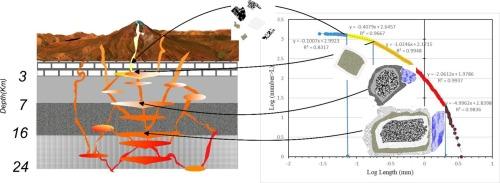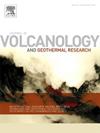The dynamic of magmatic system and volcano hazard implications of the Damavand volcano (N. Iran) inferred from the textural data
IF 2.4
3区 地球科学
Q2 GEOSCIENCES, MULTIDISCIPLINARY
Journal of Volcanology and Geothermal Research
Pub Date : 2024-11-03
DOI:10.1016/j.jvolgeores.2024.108220
引用次数: 0
Abstract
The Damavand stratovolcano (N Iran) consists mainly of lavas with trachyandesite-trachyte composition, and subordinate pyroclastic deposits. The intensity of explosive eruptions and the volume of pyroclastic deposits have increased over time, which may be related to increasing viscosity due to the development of crystal-rich magmas. This research integrates microanalytical and quantitative textural measurements to understand the textural evolutions from the old to the young lavas and their relationships with the physical processes occurred in the plumbing system. Age-constrained samples from the lavas were analyzed using crystal size distribution (CSD), the newly proposed multifractal analysis, including the Number-Length of crystals (N-LoC) and the Number-Area of crystals (N-AoC), along with mineral chemistry. Three to five populations of feldspars can be identified, which have undergone evolution and coarsening over time. We propose a textural development sequence established at mid to shallow crustal levels, involving several physicochemical processes, such as cycles of polybaric differentiation and episodic magma recharge into the crystal-rich magma chambers. This, in turn, caused disaggregation of crystal mushes and textural coarsening due to crystal aggregation and temperature cycling. The increasing population of microphenocrysts in younger lavas may be linked to pulsating groundmass crystallization resulting from degassing at a newly formed shallow chamber (0.5–1 kbar) beneath the young cone. The final stages of crystallization occurred during multi-step decompression in the conduits. The comparison of age data from lava samples and their stratigraphic positions suggests that triggering groundmass crystallization might have caused shifts in eruptive behavior.

从纹理数据推断出的达玛旺德火山(伊朗北部)岩浆系统的动态和火山灾害的影响
达马旺德平原火山(伊朗北部)主要由梯状安山岩-梯状岩成分的熔岩和附属的火成碎屑沉积物组成。随着时间的推移,爆炸性喷发的强度和火成碎屑沉积物的体积都在增加,这可能与富含晶体的岩浆发展导致粘度增加有关。这项研究综合了微观分析和定量纹理测量,以了解从老岩浆到年轻岩浆的纹理演变及其与管道系统中发生的物理过程之间的关系。利用晶体尺寸分布(CSD)、新提出的多分形分析(包括晶体数量-长度(N-LoC)和晶体数量-面积(N-AoC))以及矿物化学分析了来自熔岩的年龄限制样本。可以确定三到五个长石群,它们随着时间的推移发生了演变和粗化。我们提出了一个在地壳中浅层建立的纹理发育序列,其中涉及多个物理化学过程,如多巴分化周期和岩浆向富含晶体的岩浆腔的偶发性补给。这反过来又造成了晶体薄层的解离,以及晶体聚集和温度循环导致的纹理粗化。年轻岩浆中微晶的数量不断增加,可能与年轻锥体下方新形成的浅室(0.5-1 千巴)脱气导致的脉动地层结晶有关。结晶的最后阶段发生在导管的多级减压过程中。熔岩样本的年龄数据与其地层位置的比较表明,引发地表结晶可能导致了喷发行为的转变。
本文章由计算机程序翻译,如有差异,请以英文原文为准。
求助全文
约1分钟内获得全文
求助全文
来源期刊
CiteScore
5.90
自引率
13.80%
发文量
183
审稿时长
19.7 weeks
期刊介绍:
An international research journal with focus on volcanic and geothermal processes and their impact on the environment and society.
Submission of papers covering the following aspects of volcanology and geothermal research are encouraged:
(1) Geological aspects of volcanic systems: volcano stratigraphy, structure and tectonic influence; eruptive history; evolution of volcanic landforms; eruption style and progress; dispersal patterns of lava and ash; analysis of real-time eruption observations.
(2) Geochemical and petrological aspects of volcanic rocks: magma genesis and evolution; crystallization; volatile compositions, solubility, and degassing; volcanic petrography and textural analysis.
(3) Hydrology, geochemistry and measurement of volcanic and hydrothermal fluids: volcanic gas emissions; fumaroles and springs; crater lakes; hydrothermal mineralization.
(4) Geophysical aspects of volcanic systems: physical properties of volcanic rocks and magmas; heat flow studies; volcano seismology, geodesy and remote sensing.
(5) Computational modeling and experimental simulation of magmatic and hydrothermal processes: eruption dynamics; magma transport and storage; plume dynamics and ash dispersal; lava flow dynamics; hydrothermal fluid flow; thermodynamics of aqueous fluids and melts.
(6) Volcano hazard and risk research: hazard zonation methodology, development of forecasting tools; assessment techniques for vulnerability and impact.

 求助内容:
求助内容: 应助结果提醒方式:
应助结果提醒方式:


